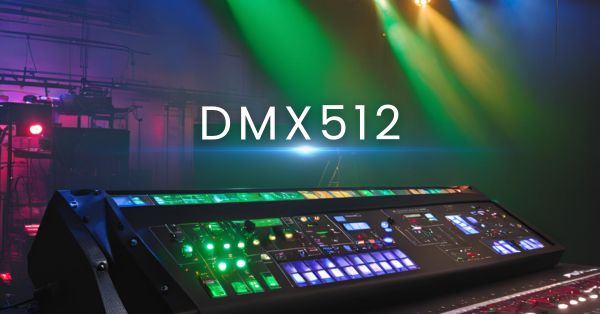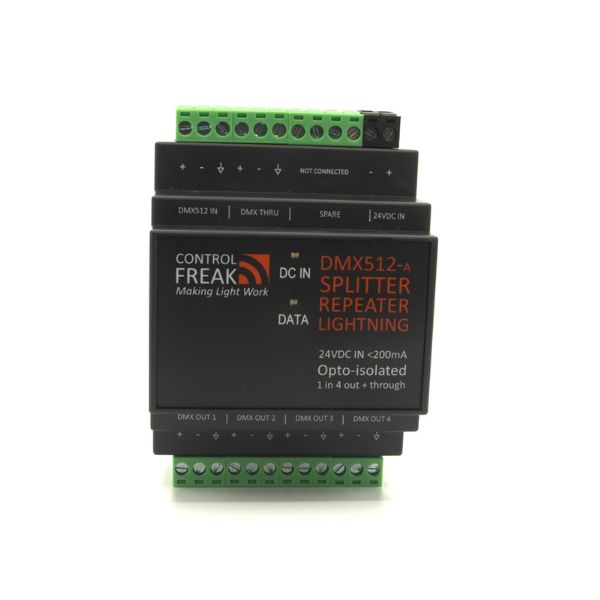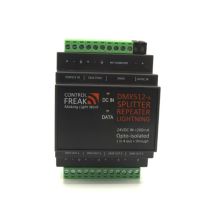How to troubleshoot DMX lighting issues and prevent reflections
DMX512, commonly referred to as DMX, is the most common digital communication protocol used to control stage lighting. DMX512 uses a data signal to manage lighting, where the signal travels through a DMX cable from the DMX control console to the connected light fixtures. A single controller can control up to 512 channels, with each channel capable of receiving a value between 0 and 255. This enables precise control over lighting intensity and effects.
DMX systems have specific limitations to ensure reliable signal transmission. According to the EIA-485 standard, a single DMX segment should not exceed 300 meters in length for optimal performance at the standard 250 kbps baud rate. Additionally, each segment should connect no more than 32 devices before requiring a splitter, such as the Control Freak DMX Splitter.
When working with DMX lighting systems, especially in larger venues or installations with long cable runs, technicians often encounter a problem known as "reflection." This issue, while common, can be a real headache for lighting professionals.
What are reflections?
Reflections are like echoes of the electrical signal that bounce back along the cable. These echoes can interfere with the original signal, causing problems such as:
- Flickering lights
- Missed commands
- Erratic behaviour of lighting fixtures
Reflections typically occur when a signal encounters an impedance mismatch in the cable. Impedance, which combines resistance, inductance, and capacitance, affects how well a conductor allows current to flow. When a signal travels through a conductor and reaches a point of sudden change—like the end of a cable—part of the signal is reflected back instead of being transmitted.
Even in well-made cables, the abrupt end creates an impedance mismatch that can cause reflections. To minimise this issue, engineers use termination resistors that match the cable's characteristic impedance. This allows the signal to be absorbed rather than reflected, preserving signal integrity and preventing distortion or data errors in high-speed systems.
It's also important to select the proper cable for DMX systems. DMX cables are designed with a characteristic impedance of 120 ohms, which is essential for maintaining signal integrity and can help minimise reflections. Standard DMX512 requires twisted-pair construction, shielding, and low capacitance, designed for RS-485.
The twisted-pair design helps cancel out electromagnetic interference, while the shielding provides additional protection against external noise. This combination ensures that the digital signals controlling the lighting remain clear and strong, even over long distances.
DMX Lighting Control Systems
Integrated DMX devices such as Control Freak’s SLAMMO V5, help reduce reflection issues by including built-in termination resistors. This feature simplifies setup for lighting technicians, as there’s no need for external resistors, ensuring proper termination right from the start. The SLAMMO V6 DMX can also be supplied with a termination resistor.
Additionally, Control Freak offers advanced splitters and repeaters, such as the Splitter V2 Lightning, designed specifically for DMX lighting systems. These devices act as signal repeaters, effectively reducing the length of stub lines and helping to maintain signal integrity over long distances. By boosting and regenerating the DMX signal, they minimise potential reflections and ensure reliable performance in complex lighting setups.
ADM is proud to have been appointed as distributors for Creative Lighting's range of Control Freak lighting control solutions. Control Freak controllers are designed to deliver stable and reliable DMX setups, as well as support protocols such as DALI, RDM, and Android. Click here to view the Control Freak product range or if you have an enquiry, contact the ADM team.




